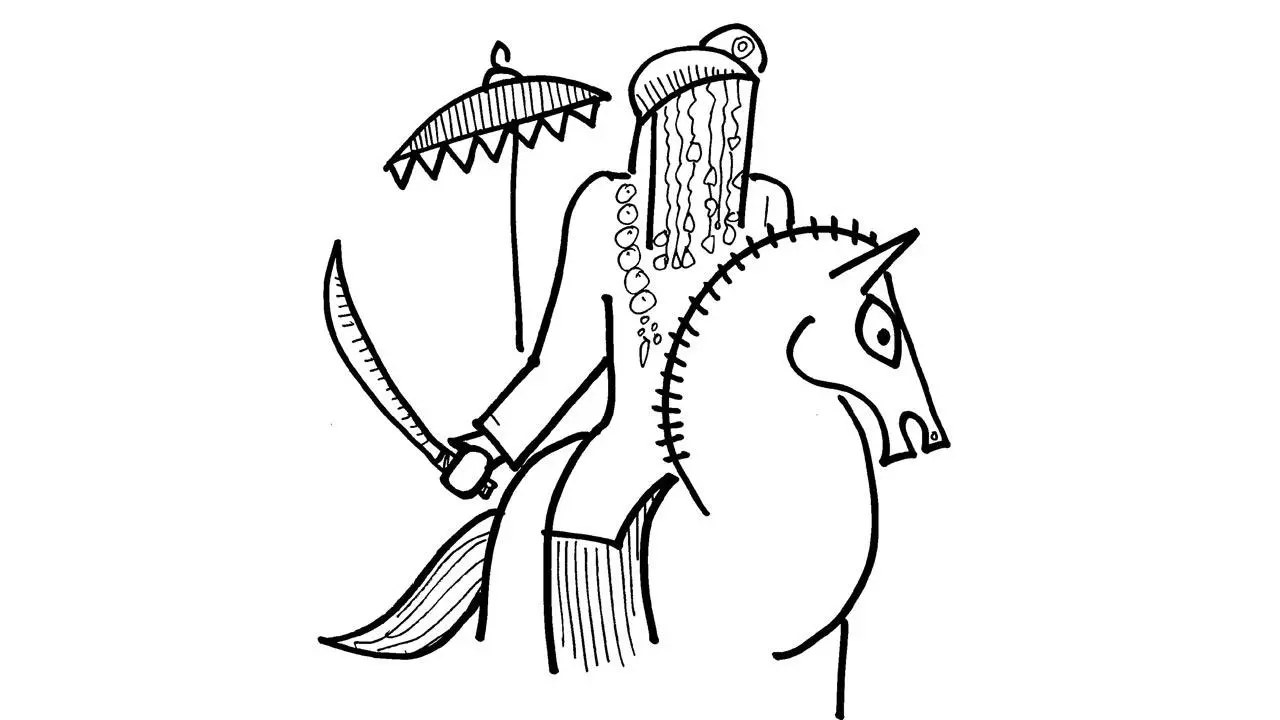Of course, it is difficult to corroborate. What is interesting, however, is that the folklore speaks of an incomplete marriage

Illustration/Devdutt Pattanaik
 Around the Holi festival, a great celebration is held in the region around Jodhpur for a male deity called Eloji, who is depicted in a state of complete sexual arousal. The erect phallus is worshipped and paraded through the streets. Many believe he is a fertility deity, perhaps once venerated by the ancient Hunas, who settled in the region during the post-Gupta period after 500 AD.
Around the Holi festival, a great celebration is held in the region around Jodhpur for a male deity called Eloji, who is depicted in a state of complete sexual arousal. The erect phallus is worshipped and paraded through the streets. Many believe he is a fertility deity, perhaps once venerated by the ancient Hunas, who settled in the region during the post-Gupta period after 500 AD.
Since the festival takes place around Holi, there is at least one folklore narrative which says that Eloji was the husband of Holika, who was summoned on the wedding night by her brother Hiranyakashyap to kill his son Prahalad. That did not go well, as Prahalad was protected by Vishnu, and it was Holika who got burnt instead. Eloji, in a state of arousal on his wedding night, was left waiting for his wife to return and is still said to be waiting. He remains faithful to her and, as the story goes, has made himself worthy of worship through this act of devotion. Of course, it is difficult to corroborate. What is interesting, however, is that the folklore speaks of an incomplete marriage.
In Hinduism, the married couple is a symbol of fertility, yet great reverence is also given to the hermit. Many heroes in North Indian lore are depicted as celibate men who marry, but before they can consummate their marriage, are killed. Thus, they exist in a liminal space between marriage and singlehood. For example, in the story of Vir Teja Ji, when his sister-in-law complains that she cannot feed him every day, he decides to get married. On learning that he is already married, he sets off to fetch his wife. On the way, he sees a burning snake and rescues it, only to be cursed by the snake for interrupting the snake’s passage to liberation. The snake wants to kill him. But Teja Ji requests them to let him complete his mission: fetch his wife, save cows, kill thieves. When he returns, all wounded, married but still having not spent a single night with his wife, the snake bites him on his tongue (the only part of his body without wounds) and he dies. He becomes a holy man, who can cure snake bites and give children to the childless.
A similar story is told of Pabuji, who is to marry Phulwanti. While at the wedding altar, he is reminded by Deval that his cows have been stolen and of his promise to rescue them. Pabuji leaves the wedding altar, fights the raiders, fulfils his vow and rescues the cows but is killed by the cattle thief. In death, he has a widow but is still celibate.
This motif is found not only in Hindu folklore but also in Indo-Islamic traditions of India. For instance, it is said that Ghazi Masood was to marry Zohra Bibi, but on the wedding day he was called away to rescue a believer who had been killed by a Hindu king. Like the Rajput heroes, Masood is killed, and Zohra Bibi dies upon hearing of his death. A great fair is held in northern India where devotees make offerings of Zohra’s dowry and commemorate the incomplete union. Such incomplete unions ensure the hero is not a monk, but married (auspicious) and also celibate (auspicious). His shrine can therefore be visited by women too.
The author writes and lectures on the relevance of mythology in modern times. Reach him at devdutt.pattanaik@mid-day.com
 Subscribe today by clicking the link and stay updated with the latest news!" Click here!
Subscribe today by clicking the link and stay updated with the latest news!" Click here!








